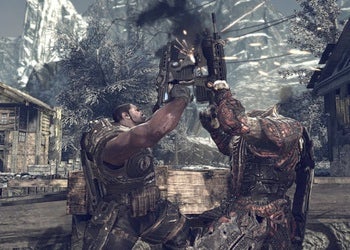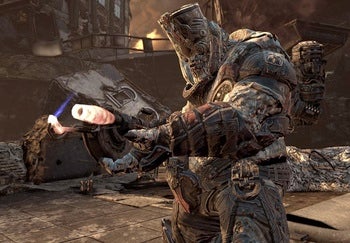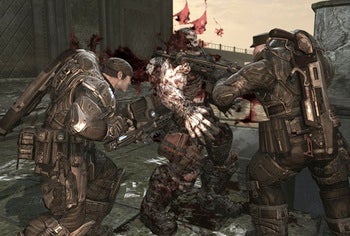
Many companies turn out SD-based camcorders in compact designs, simply because the flash-based technologies allow for much smaller models than those based on tape, hard disks, and mini DVDs. While Canon continues to offer compact AVCHD models, the Vixia HF20 and the HF200, the company's branching out with slightly more "pro" prosumer offerings in the Vixia HF S100 and the Vixia HF S10.
These two models, which record 1,920x1,080 60i video, feature a larger, faster f1.8 10x HD lens and a relatively large, high-resolution 1/2.6-inch 8-megapixel CMOS sensor, along with higher-end capabilities, such as SMPTE color bars, the ability to manually boost gain up to 18dB, fixed 70 and 100 IRE zebra stripes, and a user-assignable button/control dial combo. They differ only by internal memory: the HF S100 has none, while the HF S10 has 32GB.
Though it weighs a bit over a pound, the camcorder feels kind of light for its 2.8-inch-by-2.7-inch-by-5.4-inch dimensions. Still, it's no featherweight, and while I fit it into a loose jacket pocket it's not very compact. With only a few exceptions, the camcorder has a nice, functional design, with intelligently laid out controls and a streamlined user interface. The larger size makes it a bit more comfortable to hold and operate as well.
Looking at the camcorder head-on, one of the first things you notice is the odd built-in lens cover that uses a closing-eye type rather than aperture-blade type of design we usually see. It wouldn't be notable except that when closed, the two plastic pieces tend to rattle against each other; since the camcorder is off it's not a problem, just a minor irritation. Instead of putting the video light in the typical location on the side of the lens, Canon put it on the pop-up flash. The stereo mics sit on either side of the lens barrel. While they may be more susceptible to wind noise in that location (though I didn't have any problems), it allows for larger mics with better separation than the typical positioning above or below the lens. If that's not adequate, you can attach a mic via the mini accessory shoe on top of the camcorder. There's a 3.5mm mic input on the grip side of the unit, and the other connectors--USB, component, and miniHDMI--sit in a covered compartment underneath the strap. The strap does get in the way a little when you're hooking stuff up.
To one side of the lens Canon placed a new Custom dial, which looks, feels, and operates similarly to the control dial on Sony's prosumer models. You press the button to enable it, then use the dial to adjust whatever setting you've programmed it for--choices are exposure, focus, assist functions (70/100 IRE Zebra and peaking), mic level, and automatic gain control limit (0 to 18dB). I like it in the Sonys and here as well; it's a comfortable interface for adjusting options like exposure and focus, though I'm not fond of it for cycling through the Zebra and peaking options.
As usual, the zoom switch and photo button lie on top of the camcorder beneath your forefinger, with the mode dial right behind where an eye-level viewfinder should be; one of the biggest drawbacks of this model, geared toward enthusiasts, is the lack of an EVF. The power connector and 3.5mm headphone jack flank the mode button. One of the two record buttons lies under your thumb on the back. To the left of the zoom switch is the small, recessed power button which is a little to difficult to manipulate.
Most of the shooting controls live on the LCD bezel. The function button pulls up both the frequently used settings as well as the full menu system another level down. In addition to the usual--white balance, image effects, digital effects, video quality and still photo size, program and a handful of scene modes--the HF S10/100 offer real shutter- and aperture-priority shooting modes with a shutter speed range of 1/8 to 1/2000 second and aperture options ranging from f1.8 to f8, giving you more control over depth of field than you generally see in a prosumer model. It also offers Canon's Cine mode for adjusting color and gamma to go with its 24F progressive modes, though it and 30F get recorded as 60i. In still mode you can select metering and drive modes as well. Other high-end features accessible via the menus include three fixed or variable zoom speed, x.v.Color mode, color bars, and a test tone.
The menu system itself has been updated for a smoother feel and the ability to choose font size. Since the 2.7-inch display is the typical low-resolution model, the small fonts look pixelated and would be hard for some to read. It does stand up pretty well in direct sunlight, however.
Navigating down on the joystick while shooting triggers a fly-up menu to pop up the video light (which works in still photo mode), digital effects, 3-second prerecord, backlight and exposure compensation, manual focus, mic level, face detection, and a digital teleconverter. The options are slightly different in still mode: you gain flash and lose the mic and teleconverter. It's especially nice that you still have quick access to functions that you don't assign to the custom dial.
The HF S10/S100 also incorporate this year's features, which include Video Snapshots, 4-second clips used to create a "highlights reel" effect (the camcorders ship with a music CD). I like the idea, but the implementation can be annoying. You enter Video Snapshot mode by pressing a hard-to-feel button on the left side of the camcorder in the LCD recess. A blue outline appears on the display. When you press record, a highlight travels around the blue outline counting down your 4 seconds. It stays in Video Snapshot mode until you switch to playback or press the button again. While I like the way the display feedback works, I think I might have preferred a separate record button, or a choice on the mode dial rather than the have the isolated button. (For a complete accounting of the HF S10/100's features, you can download the PDF manual.)
Performance and quality are top notch at both its maximum 24Mbps bit rate and 17Mbps. (Recording capacities are about 5.5 minutes per gigabyte and 7.8 min/GB, respectively. Canon recommends a Class 4 or better SDHC card.) The camcorder focuses quickly and accurately, even in low light. While battery life is pretty average for its class, it recharges fairly quickly; Canon claims it takes 10 minutes per half hour of battery life. The optical stabilizer, as usual, works well out to the end of the zoom range. The video looks great: sharp, with saturated colors, and excellent exposures with relatively few blown-out highlights. The DigicDV 3 processing does a solid job maximizing the dynamic range. Living-room light-level recordings look quite good as well. There's a bit of noise and softness, but that's to be expected. The audio records crisp and clear, too. The camcorder's not perfect, however. Outdoor shots do show a bit of purple fringing on high-contrast edges, and there's some color shift in reds and blues. Still photos have a slightly overprocessed look as many camcorder stills do, and the flash does odd things to the saturation, but overall they're not bad.
If you're a video hobbyist or a pro looking for something cheap and portable to complement your workhorse equipment, the identical twins Canon Vixia HF S10 and HF S100 deliver a much better shooting experience than the current crop of $600 HD camcorders--as long as you can live without the EVF. The HF S100 is probably the better deal, since the price of a 32GB card should be less than the price differential between the two models.










